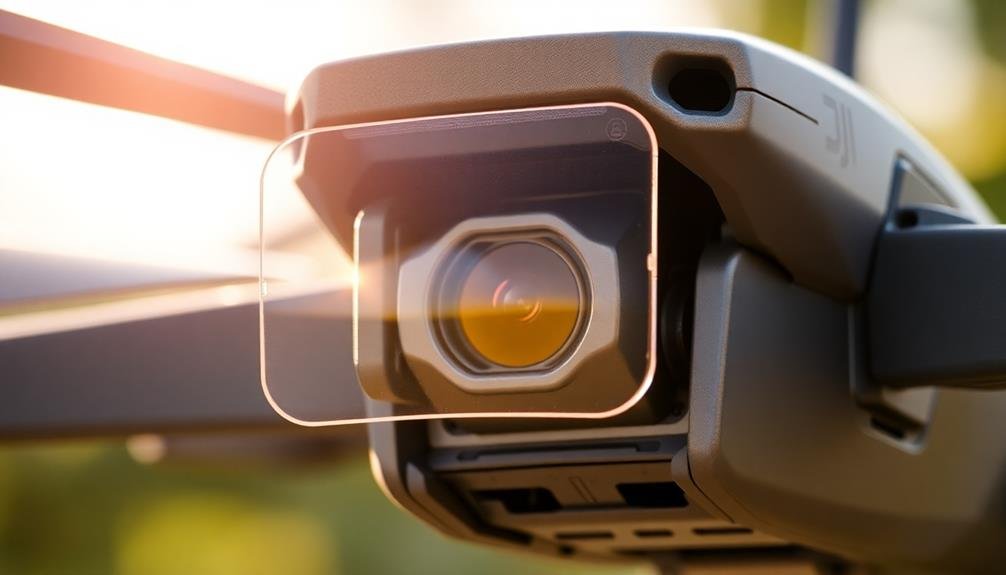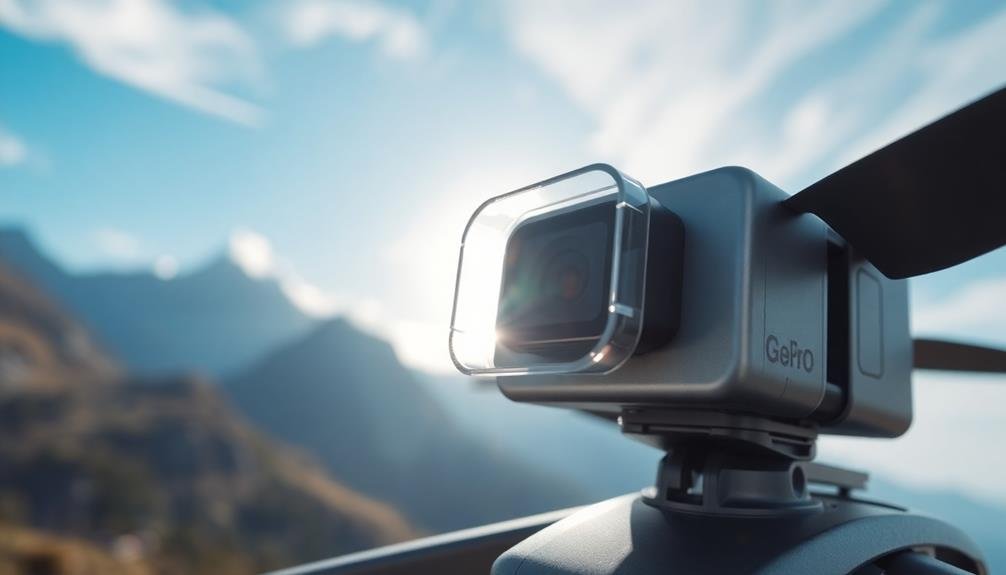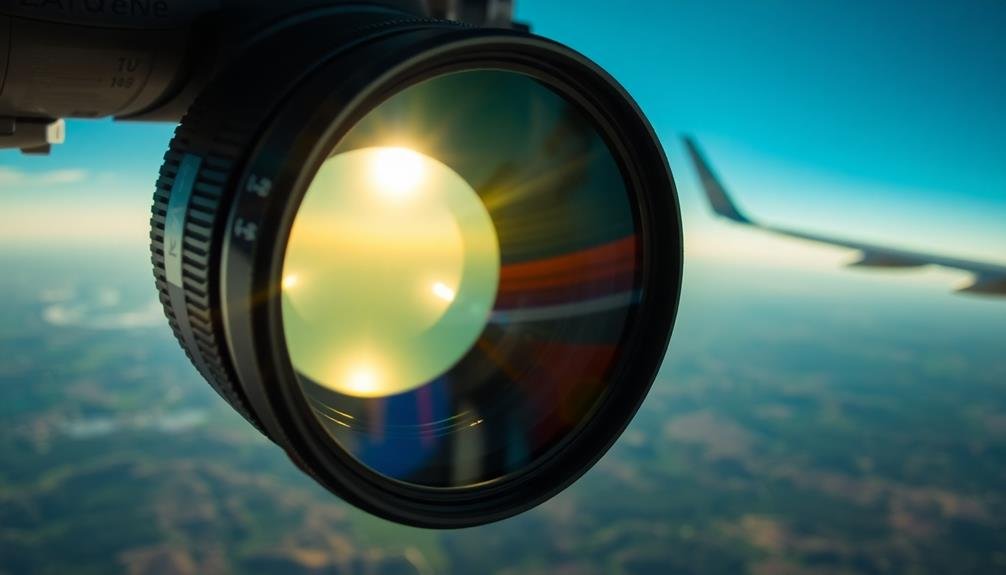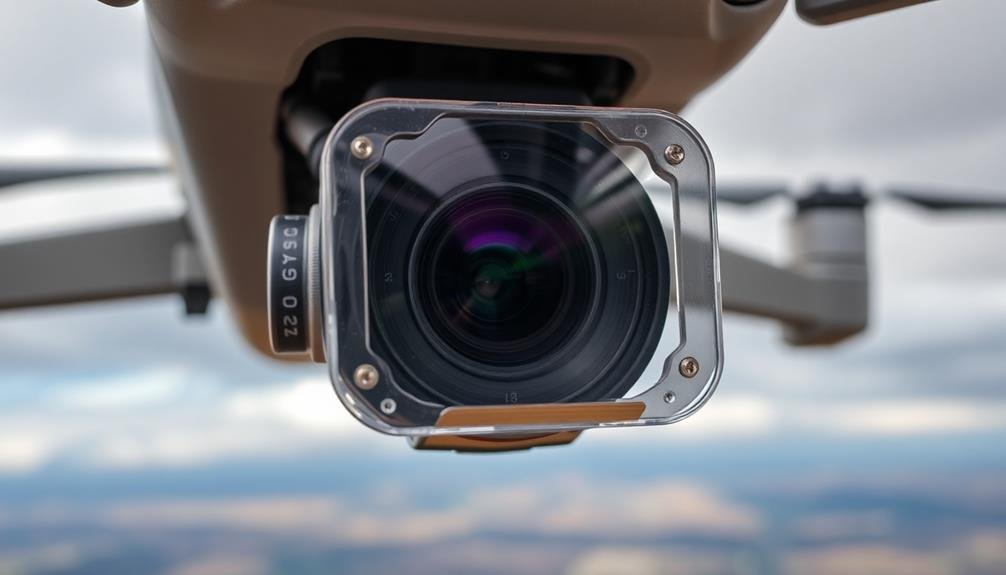When it comes to safer flight photography, you've got plenty of options to protect your camera lenses. DJI Mavic Series guards and GoPro covers offer brand-specific solutions, while universal silicone protectors fit various sizes. Carbon fiber shields provide lightweight durability, and reinforced plastic caps offer simple yet effective protection. For extensive coverage, consider gimbal guards with lens protection. Magnetic quick-release options allow for fast switches, while polarizing and UV filters enhance image quality as they safeguard. Custom 3D-printed protectors offer tailored fits, and universal silicone guards accommodate multiple lens sizes. Explore these choices to find the perfect guard for your aerial adventures.
Key Takeaways
- DJI Mavic Series Lens Guards protect drone camera lenses from scratches and impacts, with quick-release mechanisms for easy installation.
- GoPro Protective Lens Covers safeguard cameras during aerial activities, offering options like snap-on covers and full-body cases.
- Universal Silicone Lens Protectors provide versatile protection for various lens sizes, with flexible and shock-absorbing properties.
- Carbon Fiber Lens Shields offer lightweight, robust protection with superior strength-to-weight ratio, ideal for high-vibration environments.
- Gimbal Guards with Lens Protection provide comprehensive safety for both the camera lens and gimbal mechanism in one design.
DJI Mavic Series Lens Guards

In light of the DJI Mavic series' popularity, lens guards have become vital accessories for flight photographers. These protective add-ons shield your drone's camera lens from scratches, impacts, and debris during flight and transport.
DJI Mavic lens guards are specifically designed to fit the unique camera configurations of Mavic models, including the Mavic Pro, Mavic 2 Pro, and Mavic Air series.
When choosing a lens guard for your DJI Mavic, consider options made from durable materials like polycarbonate or aluminum. These materials offer excellent protection without adding significant weight to your drone.
Look for guards with a quick-release mechanism, allowing for easy installation and removal without tools. Some models feature a gimbal lock function, securing the camera in place during transport.
It's essential to select a guard that doesn't interfere with the drone's gimbal movement or obstruct the camera's field of view. High-quality lens guards often come with anti-glare and anti-reflective coatings to maintain image quality.
Remember to remove the guard before flight to guarantee peak performance and prevent any potential issues with the drone's obstacle avoidance sensors.
GoPro Protective Lens Covers

While DJI Mavic users prioritize lens protection, GoPro enthusiasts face similar concerns for their action cameras. GoPro's protective lens covers are essential accessories for safeguarding your camera during aerial photography and other high-impact activities.
These covers are typically made from durable materials like tempered glass or polycarbonate, offering a robust shield against scratches, impacts, and debris.
You'll find various options for GoPro lens protection, including snap-on covers, screw-on filters, and full-body cases. Snap-on covers are quick to install and remove, making them ideal for on-the-go use.
Screw-on filters provide added versatility, allowing you to enhance your footage with polarizers or ND filters while protecting the lens. Full-body cases offer extensive protection for your entire GoPro, including the lens, but may add bulk to your setup.
When choosing a GoPro lens cover, consider factors like compatibility with your specific model, optical clarity, and ease of use. Look for covers that don't interfere with image quality or your camera's field of view.
Some covers also feature hydrophobic coatings to repel water and reduce fogging, which is particularly useful for underwater or moisture-prone environments.
Universal Silicone Lens Protectors
Universal silicone lens protectors offer a versatile solution for safeguarding your camera lenses during flight photography.
You'll appreciate their flexible and shock-absorbing properties, which provide excellent protection against impacts and vibrations.
These protectors are easy to install and can accommodate multiple lens sizes, making them a convenient choice for photographers with diverse equipment.
Flexible and Shock-Absorbing
Beyond traditional rigid lens protectors, universal silicone lens guards offer a flexible and shock-absorbing solution for flight photographers.
These guards are designed to cushion your lens against impacts and vibrations during turbulent flights or rough landings. You'll appreciate their ability to conform to various lens shapes and sizes, ensuring a snug fit without interfering with lens functionality.
The flexibility of silicone allows these guards to absorb shocks that might otherwise damage your expensive lenses. They're particularly effective at protecting against minor bumps and scrapes that can occur when you're working in tight spaces or moving quickly to capture the perfect shot.
You'll find that the shock-absorbing properties also help reduce camera shake, potentially improving the sharpness of your images during flight.
These guards are typically lightweight and won't add significant bulk to your gear. They're easy to slip on and off, making them convenient for quick lens changes.
Many photographers prefer silicone guards because they provide a non-slip grip, enhancing your control over the camera in challenging conditions.
Remember to choose guards that are compatible with your specific lens diameters for ideal protection and performance.
Easy Installation Process
Installing universal silicone lens protectors is a breeze, making them an attractive option for flight photographers on the go. You'll find that these protectors typically come in a set of various sizes to fit different lens diameters.
To install, simply stretch the silicone guard over the front of your lens, ensuring it's centered and snug. Before installation, clean your lens thoroughly to prevent trapping dust or debris.
Once you've selected the appropriate size, gently roll the protector onto the lens, starting from one edge and working your way around. The flexible nature of silicone allows it to conform to the lens shape without leaving air bubbles.
You don't need any special tools or adhesives, which is perfect for quick changes between flights or locations. If you're using filters, most silicone protectors are thin enough to accommodate them without interference.
To remove, carefully peel the guard off from one edge. These protectors are reusable and easy to clean. Just rinse with water and mild soap, then air dry.
Their simplicity means you can quickly install or remove them as needed, adapting to changing photography conditions without missing a shot.
Fits Multiple Lens Sizes
One of the most appealing features of silicone lens protectors is their versatility across various lens sizes. You'll find that these guards can stretch to accommodate a wide range of lenses, from compact prime lenses to larger zoom lenses. This flexibility eliminates the need to purchase multiple guards for different lenses in your kit.
The elasticity of silicone allows for a snug fit on various lens diameters. Here's a quick reference guide for common lens sizes and their compatibility:
| Lens Diameter (mm) | Small Guard | Large Guard |
|---|---|---|
| 52-58 | ✓ | ✗ |
| 62-67 | ✓ | ✓ |
| 72-77 | ✗ | ✓ |
| 82-86 | ✗ | ✓ |
When selecting a silicone lens guard, you'll want to measure your lens' diameter and choose the appropriate size. Most manufacturers offer at least two sizes to cover a broad range of lenses. This adaptability guarantees that you're prepared for various shooting scenarios without carrying multiple specialized guards. Remember, a slightly larger guard can still provide adequate protection, while a guard that's too small won't fit properly.
Carbon Fiber Lens Shields

Carbon fiber lens shields offer a lightweight yet robust solution for protecting your camera lenses during flight photography. These guards are engineered to withstand the rigors of aerial shooting while adding minimal weight to your gear.
You'll appreciate the strength-to-weight ratio of carbon fiber, which provides superior protection without compromising your camera's maneuverability.
When choosing carbon fiber lens shields, consider these key features:
- Ultra-thin profile that doesn't interfere with your field of view
- Scratch-resistant coating to maintain clarity over time
- Quick-release mechanism for easy lens changes mid-flight
- Customizable fit options to accommodate various lens diameters
You'll find that carbon fiber shields excel in high-vibration environments, absorbing shocks that could otherwise damage your expensive lenses.
They're also resistant to temperature fluctuations, ensuring consistent performance at varying altitudes. Many photographers prefer carbon fiber shields for their sleek, professional appearance, which can be especially important for client-facing work.
While carbon fiber options may come at a higher price point than plastic alternatives, their durability often makes them a cost-effective choice in the long run.
You're investing in gear that'll protect your lenses for years to come, potentially saving you from costly repairs or replacements.
Gimbal Guards With Lens Protection

While carbon fiber lens shields offer excellent protection, gimbal guards with integrated lens protection take your flight photography setup to the next level. These dual-purpose guards safeguard both your camera's gimbal mechanism and lens, providing thorough protection during flights.
You'll find that gimbal guards with lens protection are designed to encase the entire camera assembly. They're typically made from lightweight yet durable materials like reinforced plastic or aluminum alloys. These guards shield your camera from impacts, debris, and moisture while allowing full range of motion for your gimbal.
The integrated lens protection feature usually consists of a clear, scratch-resistant panel that covers the front of your lens. This panel lets you shoot through it without compromising image quality while protecting your expensive glass from potential damage.
When choosing a gimbal guard with lens protection, consider factors like weight, compatibility with your specific drone model, and ease of installation.
You'll also want to verify it doesn't interfere with your drone's sensors or obstacle avoidance systems. Some models even offer quick-release mechanisms, allowing you to swiftly remove the guard for cleaning or lens changes.
Reinforced Plastic Lens Caps

Protecting your camera lens during flight doesn't always require complex solutions. Reinforced plastic lens caps offer a simple yet effective way to safeguard your equipment. These durable caps are designed to withstand the rigors of aerial photography, providing a barrier against impacts, dust, and moisture.
When choosing reinforced plastic lens caps, look for options that feature:
- Shock-absorbing materials that cushion your lens from sudden jolts
- Textured surfaces for easy grip, even with gloves
- Secure locking mechanisms to prevent accidental removal
- Lightweight construction to minimize added weight to your gear
You'll find that these caps are often custom-fitted to specific lens models, ensuring a snug fit. They're easy to snap on and off, allowing for quick lens changes mid-flight.
Unlike standard lens caps, reinforced versions are built to endure extreme conditions, including rapid temperature changes and high-altitude pressures.
While they may cost more than basic caps, reinforced plastic lens caps are a worthwhile investment for aerial photographers. They'll protect your valuable lenses from scratches, impacts, and environmental hazards, potentially saving you from costly repairs or replacements.
Remember to always secure your lens cap before takeoff and during landing to maximize protection.
Magnetic Quick-Release Lens Guards

Magnetic quick-release lens guards offer a modern twist on lens protection for flight photography. These innovative guards use strong magnets to attach securely to your camera lens, providing a fast and efficient way to shield your optics during flights.
You'll appreciate the ease with which you can snap them on and off, allowing for quick shifts between shooting and protecting your equipment.
These guards typically consist of a metal ring that attaches to your lens and a corresponding cover with embedded magnets. The magnetic connection guarantees a tight seal, keeping out dust, moisture, and potential impacts.
You'll find that many models are designed to be stackable, allowing you to carry multiple filters or accessories without removing the guard.
When choosing a magnetic lens guard, consider the strength of the magnets, as you'll want a secure hold during turbulent flights. Look for guards made from durable materials like aircraft-grade aluminum or reinforced polymers.
Some models even feature additional padding for extra shock absorption. You'll also want to verify compatibility with your specific lens diameter and any existing filter threads.
Polarizing Filters as Lens Shields

Polarizing filters serve a dual purpose in flight photography, acting as both a creative tool and a protective shield for your lens. When attached to your camera, these filters not only enhance image quality by reducing glare and improving color saturation but also provide a physical barrier against potential hazards during flight.
You'll find that polarizing filters are particularly useful in aerial photography for:
- Cutting through haze and increasing visibility of landscapes below
- Enhancing the contrast between sky and clouds
- Eliminating reflections from water surfaces or aircraft windows
- Deepening the blue of the sky for more dramatic shots
As a lens guard, the polarizing filter adds an extra layer of protection without compromising image quality. It's a cost-effective solution that can save your expensive lens from scratches or impacts caused by debris or accidental bumps during turbulence.
When choosing a polarizing filter for flight photography, opt for high-quality, multi-coated options that won't degrade your image. Consider slim profiles to avoid vignetting, especially with wide-angle lenses.
Remember to clean your filter regularly, as it'll be exposed to various elements during flights. By using a polarizing filter, you're not only enhancing your photos but also ensuring your lens stays safe throughout your aerial adventures.
UV Filters for Lens Safety

For decades, UV filters have been a staple in photographers' kits, and they're especially valuable for flight photography. These clear, lightweight filters screw onto the front of your lens, providing a protective barrier against dust, scratches, and impacts. When you're shooting from an aircraft, they're your first line of defense against unexpected debris or accidental bumps.
UV filters offer more than just physical protection. They can enhance image quality by reducing haze and improving contrast, particularly at high altitudes where UV light is more intense. While modern digital sensors are less sensitive to UV light than film, these filters can still make a noticeable difference in your aerial shots.
Here's a quick comparison of UV filter options:
| Brand | Price Range | Coating | Durability |
|---|---|---|---|
| Hoya | $20-$100 | Multi-coated | High |
| B+W | $30-$200 | Nano-coated | Very High |
| Tiffen | $10-$50 | Single-coated | Moderate |
| Breakthrough | $50-$150 | Nano-coated | High |
When choosing a UV filter for flight photography, consider investing in a high-quality, multi-coated option. It'll provide better protection and optical performance, ensuring your airborne shots are crisp and clear.
Custom 3D-Printed Lens Protectors

You'll find custom 3D-printed lens protectors offer a tailored fit for your specific camera lenses, ensuring ideal protection during flight photography.
These lightweight guards are crafted from durable materials, providing robust defense against impacts and debris without adding significant weight to your gear.
With customizable design options, you can create lens protectors that not only safeguard your equipment but also reflect your personal style or branding preferences.
Tailored Fit for Lenses
In recent years, custom 3D-printed lens protectors have revolutionized flight photography gear.
These tailored guards offer a perfect fit for your specific lens models, ensuring maximum protection without compromising functionality. You'll find that these custom-made protectors provide a snug, secure fit that's far superior to generic, one-size-fits-all options.
When you opt for a tailored lens guard, you're investing in a solution that's precisely engineered for your equipment.
The 3D printing process allows for intricate designs that account for every curve and button on your lens. This level of customization means you won't have to worry about:
- Blocked controls or switches
- Obstructed focus or zoom rings
- Interference with lens hoods or filters
- Gaps that could let in dust or moisture
Lightweight, Durable Materials
The materials used in custom 3D-printed lens protectors are just as important as their tailored fit. You'll want to choose lightweight yet durable materials that won't add unnecessary weight to your camera setup during flight. Nylon and ABS plastics are popular choices for 3D printing, offering a good balance of strength and flexibility.
Nylon is known for its impact resistance and durability, making it ideal for protecting your lens from accidental bumps or drops. It's also resistant to abrasion, guaranteeing your protector maintains its shape and effectiveness over time.
ABS, on the other hand, offers excellent rigidity and heat resistance, which can be vital in varying flight conditions.
Some manufacturers are now experimenting with carbon fiber-infused filaments, combining the ease of 3D printing with the strength-to-weight ratio of carbon fiber. These advanced materials provide superior protection while keeping the overall weight to a minimum.
When selecting a material for your lens protector, consider the specific demands of your flight photography. Factor in the environmental conditions you'll face, such as temperature fluctuations and potential impacts.
Customizable Design Options
Release your creativity with custom 3D-printed lens protectors that offer a wide range of design options. You'll have the freedom to tailor your lens guard to your specific needs and preferences.
Whether you're looking for enhanced protection, improved aesthetics, or unique functionality, 3D printing technology allows for limitless possibilities.
With customizable designs, you can:
- Add personalized textures or patterns to improve grip and handling
- Incorporate your logo or branding for a professional touch
- Design specialized attachment points for accessories like filters or lens caps
- Create aerodynamic shapes to minimize wind resistance during flight
You're not limited to off-the-shelf options anymore. By working with a 3D printing service or using your own printer, you can bring your ideas to life.
Choose from a variety of materials, including durable plastics and lightweight composites, to achieve the perfect balance of protection and weight.
Don't forget to take into account factors like lens compatibility, camera body fit, and ease of installation when designing your custom protector.
With careful planning and creativity, you'll have a unique, functional lens guard that meets your exact specifications for safer flight photography.
Frequently Asked Questions
How Do Lens Guards Affect Image Quality and Camera Performance?
You'll notice lens guards can slightly reduce image sharpness and light transmission. They may cause minor vignetting or flare in certain conditions. However, they won't considerably impact your camera's overall performance or autofocus capabilities.
Can Lens Guards Be Used With ND Filters Simultaneously?
Yes, you can use lens guards with ND filters simultaneously. You'll need to verify compatibility and proper installation. Some guards have built-in filter threads, while others may require adapters. Always check your specific equipment for the best setup.
Are Lens Guards Waterproof for Underwater Drone Photography?
You'll find that most lens guards aren't waterproof for underwater drone photography. They're designed for aerial use, not submersion. If you're planning underwater shots, you'll need specially designed waterproof housing for your camera instead.
How Often Should Lens Guards Be Replaced for Optimal Protection?
You should replace lens guards regularly, depending on usage. If you're a frequent flyer, consider changing them every 3-6 months. Always inspect for damage after each flight and replace immediately if you notice any scratches or cracks.
Do Lens Guards Interfere With Obstacle Avoidance Sensors on Drones?
You'll find that lens guards can potentially interfere with obstacle avoidance sensors on some drones. It's essential to check your specific model's compatibility. If interference occurs, you might need to choose between protection and sensor functionality.
In Summary
You've now got a great selection of lens guards to choose from for your aerial photography adventures. Whether you opt for brand-specific protectors or universal options, you'll be adding an extra layer of safety to your camera. Don't forget to take into account filters that serve double duty as shields. With these guards in place, you can fly with more confidence, knowing your lens is protected from potential impacts or debris. Happy shooting!

As educators and advocates for responsible drone use, we’re committed to sharing our knowledge and expertise with aspiring aerial photographers.




Leave a Reply